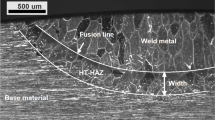Abstract
The article discusses the results of research on the development of welding technology for Inconel 600 alloy. The aim of the research is to apply this technology to the production of retorts for gas nitriding furnaces, which must be resistant to aggressive chemical agents and the influence of high temperature. Studies that assess the impact of gas on the quality of the weld deposited on the samples. The research included the development of the initial welding technology, welding tests, observation and measurement of the padding weld face and fusion depth, as well as advanced tests of the microstructure of the pad welded layers. The highest fusion depth during padding was obtained in Ar + 2%O2 mixture. During the padding with a wire with a diameter of 1.2 mm, the metal sheet was fused through from a thickness of 3 mm. Slightly deeper fusion and a more favourable shape of the fusion surface were obtained by setting the handle at an angle of 80°. The most comparable conditions of padding in different gas shields were obtained with 50% Twin Pulse in the arc.
Graphical abstract












Similar content being viewed by others
References
Briant CL, O’Toole CS, Hall EL. The effect of microstructure on the corrosion and stress corrosion cracking of alloy 600 in acidic and neutral environments. Corrosion. 1986;42:15–27. https://doi.org/10.5006/1.3584874.
Karthik D, Swaroop S. Laser shock peening enhanced corrosion properties in a nickel based Inconel 600 superalloy. J Alloys Compd. 2017. https://doi.org/10.1016/j.jallcom.2016.10.093.
Do Kim J, Moon JH. C-ring stress corrosion test for Inconel 600 and Inconel 690 sleeve joint welded by Nd:YAG laser. Corros Sci. 2004. https://doi.org/10.1016/S0010-938X(03)00098-2.
Hu HX, Zheng YG, Qin CP. Comparison of Inconel 625 and Inconel 600 in resistance to cavitation erosion and jet impingement erosion. Nucl Eng Des. 2010. https://doi.org/10.1016/j.nucengdes.2010.07.021.
Park HB, Kim YH, Lee BW, Rheem KS. Effect of heat treatment on fatigue crack growth rate of Inconel 690 and Inconel 600. J Nucl Mater. 1996. https://doi.org/10.1016/0022-3115(96)00372-8.
Jamrozik W, Górka J, Kik T. Temperature-based prediction of joint hardness in TIG welding of inconel 600, 625 and 718 nickel superalloys. Materials (Basel). 2021. https://doi.org/10.3390/ma14020442.
Avery RE, Tuthill AH. Guidelines for the welded fabrication of nickel alloys for corrosion-resistant service. In: Velopment Ref. B.; 1994.
Sato YS, Arkom P, Kokawa H, Nelson TW, Steel RJ. Effect of microstructure on properties of friction stir welded Inconel Alloy 600. Mater Sci Eng A. 2008. https://doi.org/10.1016/j.msea.2007.07.002.
Song KH, Fujii H, Nakata K. Effect of welding speed on microstructural and mechanical properties of friction stir welded Inconel 600. Mater Des. 2009. https://doi.org/10.1016/j.matdes.2009.05.033.
Han WJ, Byeon JG, Park KS. Welding characteristics of the Inconel plate using a pulsed Nd:YAG laser beam. J Mater Process Technol. 2001. https://doi.org/10.1016/S0924-0136(01)00718-X.
Song KH, Tsumura T, Nakata K. Development of microstructure and mechanical properties in laser-FSW hybrid welded inconel 600. Mater Trans. 2009. https://doi.org/10.2320/matertrans.M2009058.
Chandrasekar G, Kailasanathan C, Vasundara M. Investigation on un-peened and laser shock peened dissimilar weldments of Inconel 600 and AISI 316L fabricated using activated-TIG welding technique. J Manuf Process. 2018. https://doi.org/10.1016/j.jmapro.2018.09.004.
Herrera-Chávez LY, Ruiz A, López-Morelos VH, Rubio-González C. Microstructural characterization and mechanical response of Inconel 600 welded joint. Mater Charact. 2019. https://doi.org/10.1016/j.matchar.2019.109882.
Srikanth A, Manikandan M. Development of welding technique to avoid the sensitization in the alloy 600 by conventional Gas Tungsten Arc Welding method. J Manuf Process. 2017. https://doi.org/10.1016/j.jmapro.2017.10.014.
Aminipour N, Derakhshandeh-Haghighi R. The effect of weld metal composition on microstructural and mechanical properties of dissimilar welds between Monel 400 and Inconel 600. J Mater Eng Perform. 2019. https://doi.org/10.1007/s11665-019-04328-0.
Sudha C, Anand R, Thomas Paul V, Saroja S, Vijayalakshmi M. Nitriding Kinetics of Inconel 600. Surf Coatings Technol. 2013;226:92–9. https://doi.org/10.1016/j.surfcoat.2013.03.040.
Abraham GJ, Bhambroo R, Kain V, Dey GK, Raja VS. Intergranular corrosion susceptibility of alloy 600 after autogenous tungsten inert gas and laser beam welding using electrochemical technique. High Temp Mater Process. 2014;33:137–46. https://doi.org/10.1515/htmp-2013-0045.
Funding
Presented results of research were carried out within the research task “Preliminary studies on additive manufacturing technology of cooling channels in forging tools” financed from the funds of the pro-quality subsidy for the development of the research potential of the Faculty of Mechanical Engineering of the Wroclaw University of Technology in the year 2022.
Author information
Authors and Affiliations
Corresponding author
Ethics declarations
Conflict of interest
All authors declare that he/she has no conflict of interest.
Ethical approval
This article does not contain any studies with human participants or animals performed by any of the authors.
Additional information
Publisher's Note
Springer Nature remains neutral with regard to jurisdictional claims in published maps and institutional affiliations.
Rights and permissions
About this article
Cite this article
Lange, A., Widomski, P., Kaszuba, M. et al. Influence of gas shielding type and welding parameters on weld geometry and selected properties of welded joints from INCONEL 600. Archiv.Civ.Mech.Eng 22, 150 (2022). https://doi.org/10.1007/s43452-022-00470-0
Received:
Revised:
Accepted:
Published:
DOI: https://doi.org/10.1007/s43452-022-00470-0




